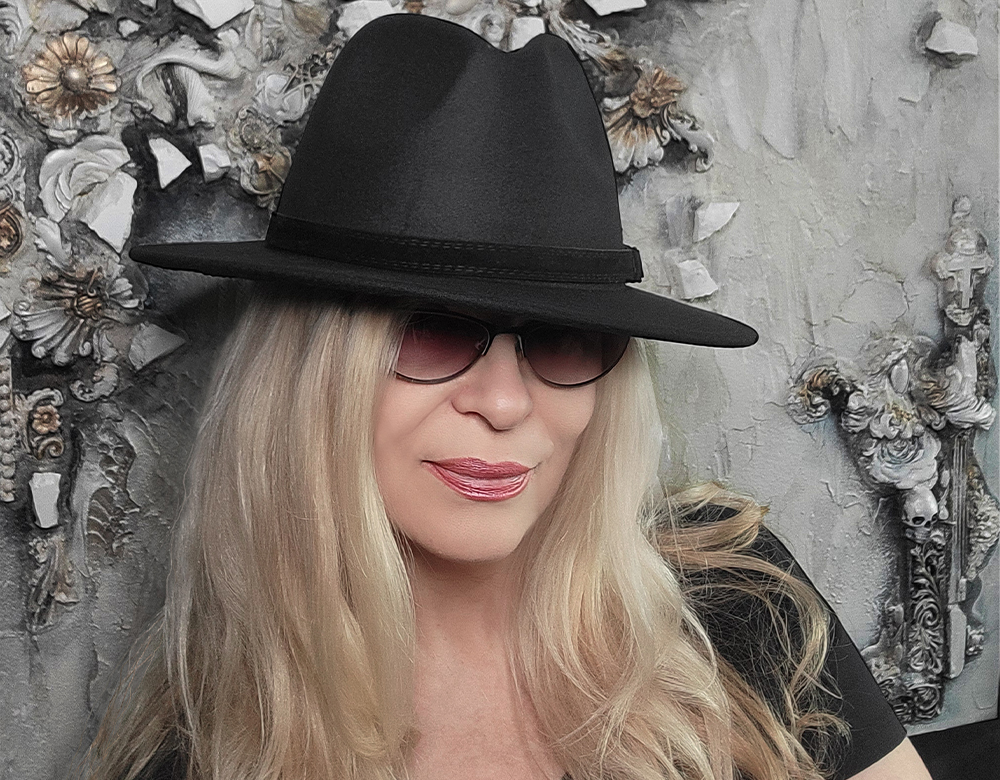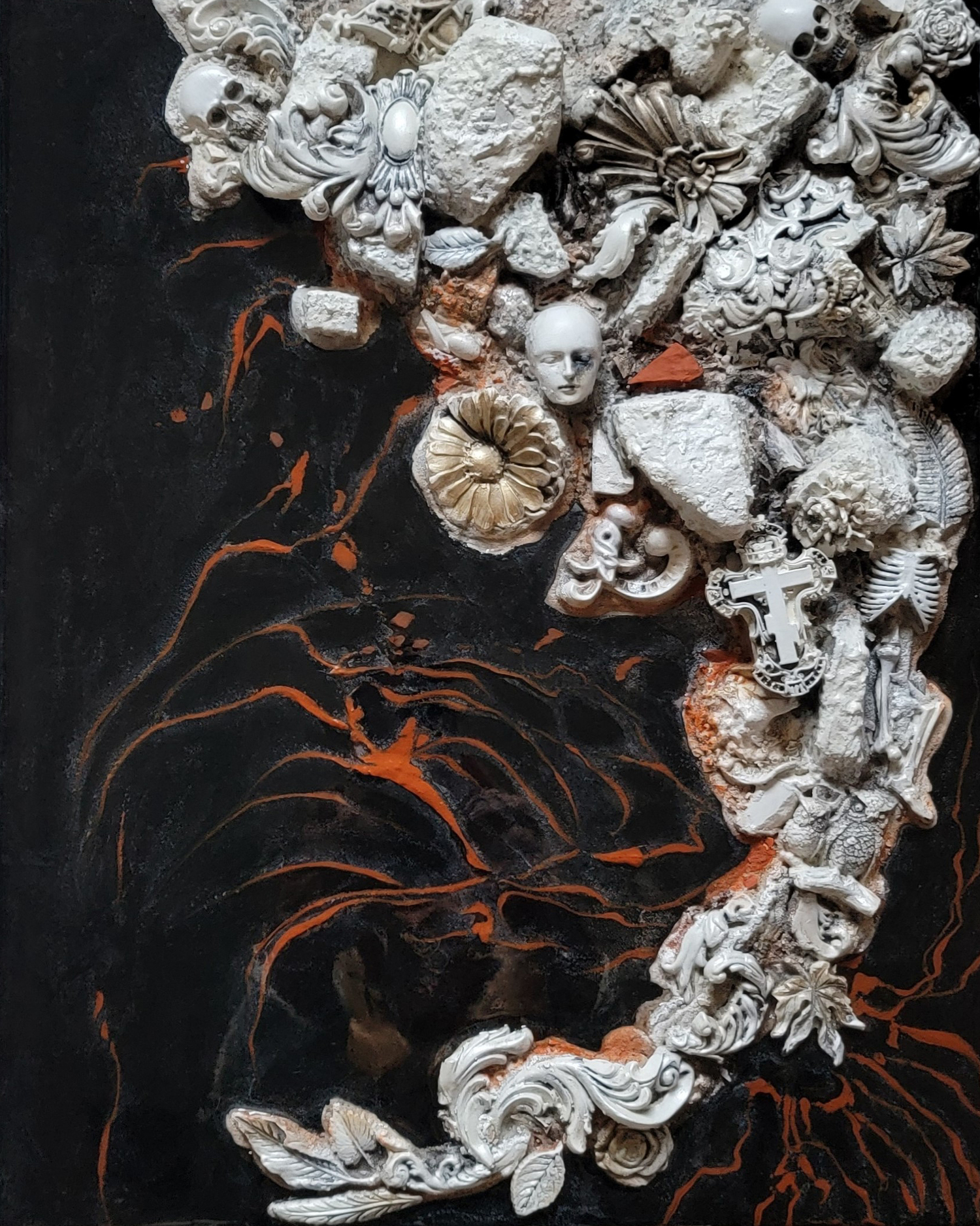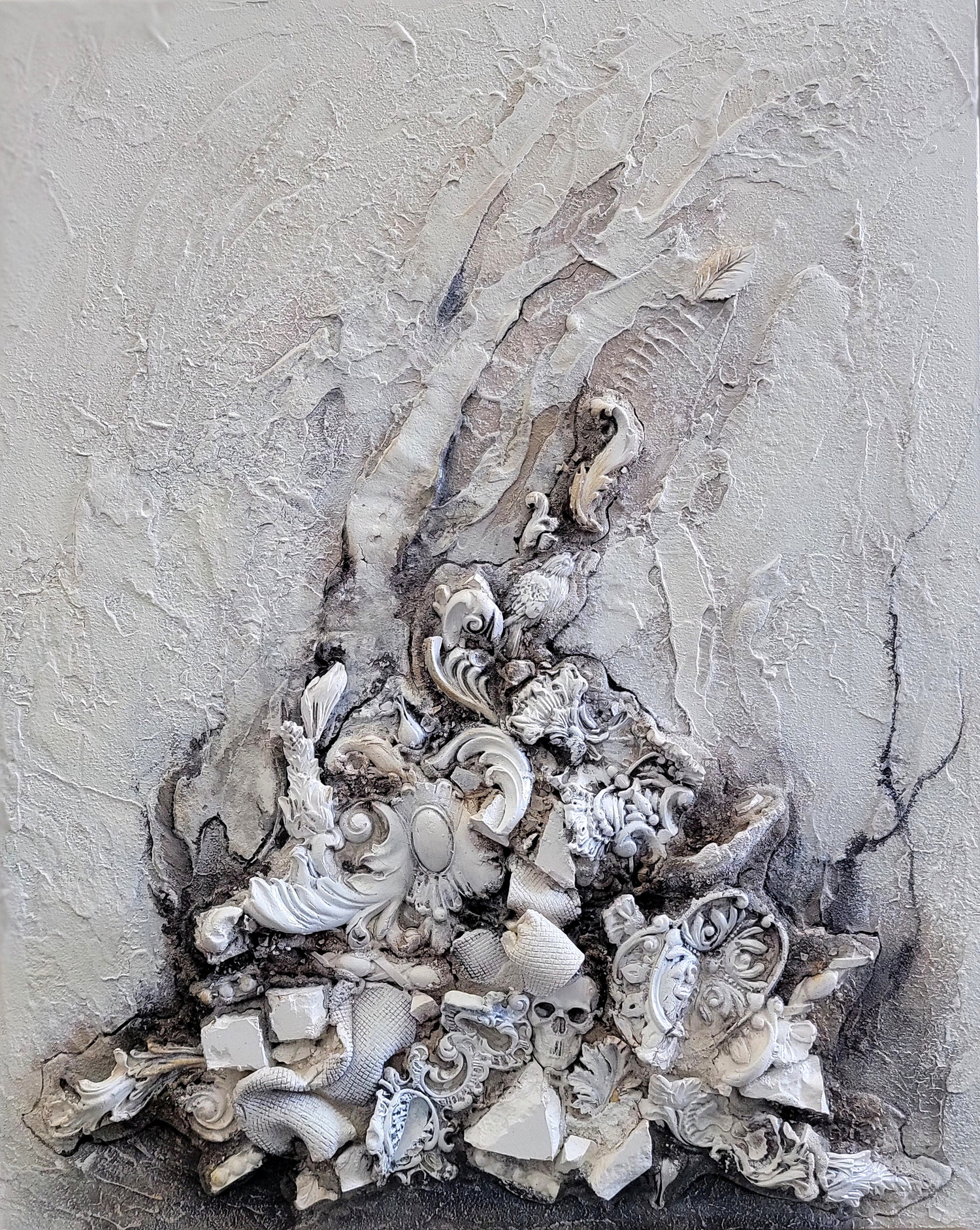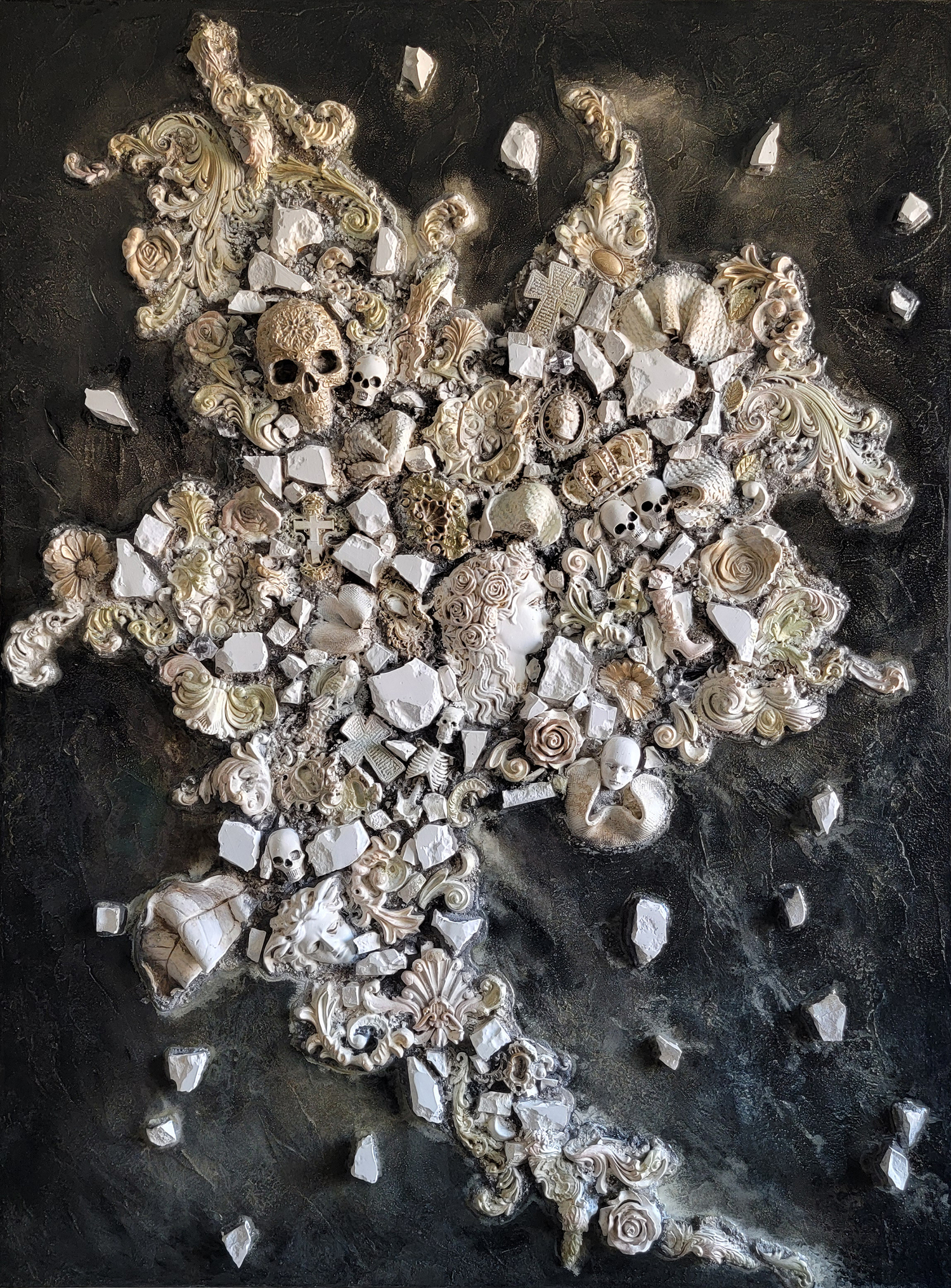Sana Shaw
Where do you live: Houston, TX
Your education: Two master’s degrees in art (University of Printing, Moscow, and Architectural Academy, Yekaterinburg)
Describe your art in three words: Interdisciplinarity, Neo-Decadence, Symbolism
Your discipline: sculptural artworks (wall sculptures)
Website | Instagram

Your work spans many disciplines such as art, fashion, philosophy, and futurology. How do you manage to blend these diverse areas into a cohesive artistic practice?
I have always been fascinated by the humanities, which have helped me gain a deeper understanding of the world’s structure, the dynamics of society, and the interconnectedness of people and culture. This knowledge has become an integral part of my artistic practice, where I explore the transformations of the contemporary world. I am particularly interested in the processes of destruction familiar world orders and security systems, the construction of new frameworks, and how these changes impact individuals. I work within an interdisciplinary field. For me, art is a way to merge my knowledge from various disciplines, using symbolism and imagery to better comprehend these shifts and to offer new perspectives on the interaction between the past, present, and future.
You’ve mentioned that your art reflects the “zeitgeist” of our time. Could you explain how your work engages with the political, social, and cultural shifts of the present day?
My art reflects the “zeitgeist” by exploring the transformations that contemporary society is undergoing. We live in an era of profound political, social, and cultural shifts that challenge established systems and beliefs. In my work, I strive to capture these pivotal moments: the dismantling of old power structures, the renewal of global frameworks, the search for new identities, and the reevaluation of the relationship between individuals and society.
I draw on materials, symbols, and a visual language that highlight the fragility and duality of our time—destruction and creation, tradition and innovation, loss and hope. For instance, the use of industrial materials or decorative elements from past cultures in my works reflects the collision between the past and the future, reminding us that every crisis carries the potential for renewal and rebirth. What has been destroyed must be recreated in a better form, as society ascends the ladder of evolution.
Through this, I aim to create a space for dialogue about how we adapt to these changes and what values we choose to build a new reality.
 Sana Shaw, Fragility of life, 2024
Sana Shaw, Fragility of life, 2024
Your pieces often incorporate industrial materials and broken antique elements. What is the significance of these materials in relation to the themes of destruction and creation in your work?
I work with industrial construction materials to express ideas of destruction and the creation of a new order. Materials such as cement, stucco, or plaster are construction elements that literally illustrate my concept. They also symbolize the utilitarianism and rawness of the modern era, while the use of non-artistic materials on canvas emphasizes the transition from traditional forms of art to new conceptual approaches.
The broken elements of antique styles like Baroque and Gothic serve as metaphors for the fragments of bygone eras, evoking the remnants of cultural and social structures we witness today. They emphasize the idea that the past does not completely disappear but transforms, becoming an integral part of a new worldview.
I intentionally use non-artistic materials, broken stones, and decorative elements to evoke a sense of tension and fragility that many people feel in our time. The black-and-white palette enhances this effect, creating a stark contrast between extremes—destruction and restoration, loss and hope.
I also resonate with the ideas of European Decadence, where uncertainty and disillusionment brought on by crises were expressed through aestheticism and symbolism. Much like the artists of that time, I strive to aestheticize the process of destruction and renewal, highlighting its inevitability and beauty. My approach creates a dialogue between the past and the present, chaos and order, forming a visual metaphor for the transformative potential of human experience.
How do you see your art reflecting the ongoing transition from the old world to the new world, as mentioned in your artist statement?
My art reflects the transition from the old world to the new through visual and conceptual elements that explore the conflict inherent in this process. I am aware that we live in an era where old systems and cultural codes are collapsing, giving way to new but still unsteady structures. This state of being in-between, oscillating between destruction and creation, is embodied in my work.
Broken forms of ancient styles symbolize the fragments of the past in my art—pieces we cannot completely discard but that, through transformation, become part of the future. These elements evoke eternity, archaeology, and memory, emphasizing that even in destruction lies the potential for new creation.
Each component—from remnants of the past to contemporary materials—becomes part of a dialogue about how old structures evolve to pave the way for a new world order.
I strive to show that the transition from one worldview to another is always accompanied by contradictions: the stability of the past clashes with the uncertainty of the future, and destruction reveals opportunities for creation. This state of transition is conveyed through the interplay of contrasts in materials, forms, and symbols. At the same time, my art not only captures these changes but also offers viewers a space to reflect on their own roles and choices amid this global shift.
 Sana Shaw, Fragility of life, 2024
Sana Shaw, Fragility of life, 2024
The interplay of destruction and creation seems central to your practice. Can you talk about a specific piece where you felt this tension most strongly?
Yes, of course. However, over time I’ve noticed that I’ve been focusing more and more on the processes of restoration and creation of the new world. Perhaps we are on the cusp of major change.
One of my first works in this theme, entitled Fragments of an Old Reality 4, a rather large work in size and conceptualization, gave me the opportunity to feel most strongly this tension of unpredictability and unreliability that was in the air. Perhaps because it was one of the first, everything felt very acute and painful, I didn’t yet have the understanding and confidence that things are moving forward, the world is changing and I hope it’s changing for the better.
Many of your works evoke a sense of timelessness and reference history. How do you approach the concept of eternity in your work, especially when juxtaposing contemporary elements with ancient references?
The concept of eternity in my works is expressed through the juxtaposition of ancient elements with contemporary symbols and materials. I aim to show that the processes of destruction and creation, which may seem specific to the present moment, are, in fact, eternal and inevitable. By incorporating elements from antiquity, Baroque, and Gothic styles, I create a connection to the past, which, despite its destruction, continues to live in our perception and influence the present. I use these elements as a metaphor for eternity, intertwined with the ever-changing world we inhabit.
The interplay of ancient and modern elements in my works demonstrates how different eras can coexist within a single piece of art. In this context, eternity is not perceived as a static category but as an ongoing process where the old and the new intertwine, creating something entirely different and meaningful. My art is an attempt to capture this moment of transition, where the past and the present converge, shaping a new understanding of eternity in the face of change.
 Sana Shaw, Renewal of the world, 2024
Sana Shaw, Renewal of the world, 2024
How does your background in fashion design influence your current practice, especially in terms of structure, texture, and aesthetics?
My experience in fashion design has a significant impact on my current artistic practice. In fashion, I learned to work with materials, master new modeling techniques, and find a balance between functionality and art. I’ve carried this approach into my sculptural work, where structure and texture have become essential elements of composition.
I often use industrial materials and unconventional elements, such as plaster or broken stones, which echo the work with fabrics and textures in fashion design. Fashion thinking allows me to create more layered, contrasting, and engaging compositions, where each element holds symbolic meaning, and its perception depends on how it is evaluated visually and tactually.
Additionally, the aesthetics I developed in fashion design help me create more precise and expressive forms, establishing a connection between modernity and the past, between the utilitarian and the artistic. In my work, I aim to convey harmony between destruction and creation, and fashion design, as a tool for transformation, serves as a powerful example of this idea within the realms of painting and sculpture.
Aesthetics in my art often serve as a way to illuminate issues and pain, making them not only visible but also accessible in a different, more beautiful and harmonious form. I tend to aestheticize difficult and painful themes, presenting them as parts of a broader process of transformation, where destruction and suffering become catalysts for change and creation. Through this, I hope to show that even in the darkest and most challenging aspects of human existence, there is space for beauty and self-expression.

Leave a Reply